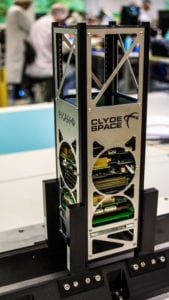Clyde Space Explores Use of Cold Atoms for Space Apps

The CASPA payload will fly atop a Clyde Space 3u CubeSat. Photo: Clyde Space.
Clyde Space has formed a partnership with conglomerate Teledyne e2v to use quantum technology to provide a solution capable of creating “cold atoms” in space. According to Clyde Space, laboratory experiments have shown cold atoms can be used as ultra-sensitive sensors capable of mapping tiny changes in the strength of gravity across the Earth’s surface.
The technology is based on new developments in quantum technology, which have resulted in the ability to cool atoms close to absolute zero. Applications for instruments based on this technology include more accurate monitoring of changes in polar ice mass, ocean currents and sea level, the ability to monitor underground water resources and discover new underground natural resource deposits that are currently not detectable, according to Clyde Space. The technology can also be used for deep-space navigation and for providing higher precision timing sources in space.
Clyde Space and Teledyne will replicate the use of cold atoms as ultra-sensitive sensors with the Cold Atom Space Payload (CASPA) mission, a free-flying on-orbit demonstration funded by Innovate UK.